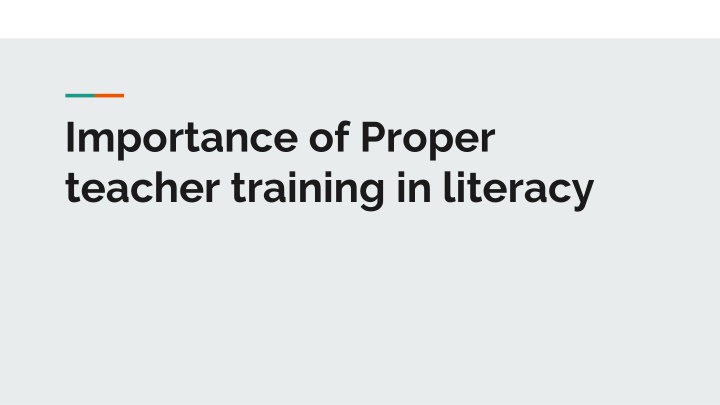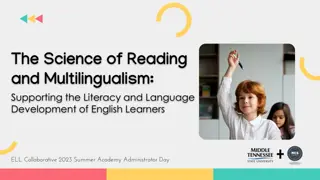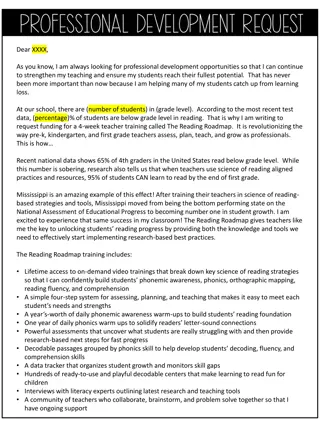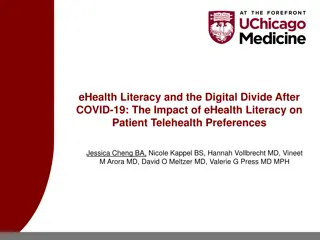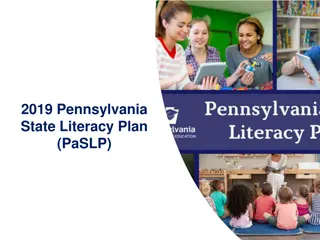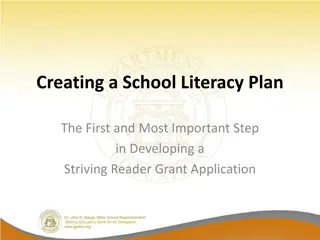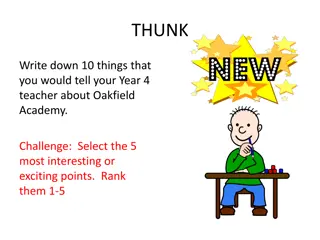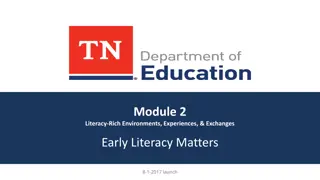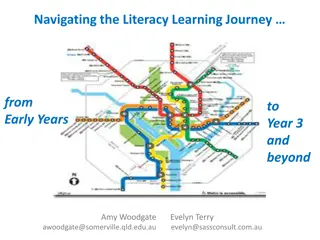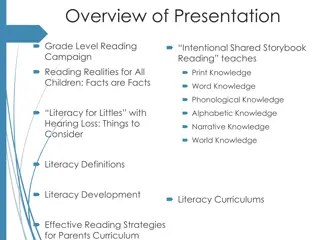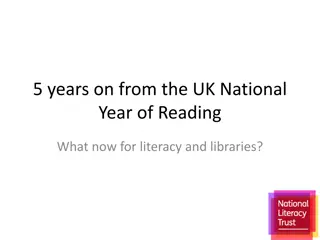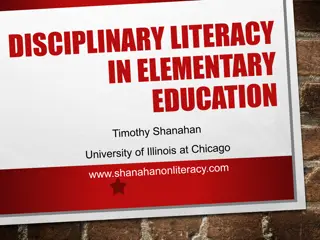Importance of Proper Teacher Training in Literacy: The Science Behind Reading
Effective literacy training for teachers is crucial for improving reading scores, especially among disadvantaged students. Research shows that with evidence-based strategies, 95% of children can learn to read. It is essential to teach reading explicitly and systematically, emphasizing skills like decoding, language comprehension, and building content knowledge. Early knowledge acquisition is likened to compound interest, emphasizing the importance of starting literacy education early. View the full article for in-depth insights into the science behind reading and the significance of proper teacher training in literacy.
Download Presentation

Please find below an Image/Link to download the presentation.
The content on the website is provided AS IS for your information and personal use only. It may not be sold, licensed, or shared on other websites without obtaining consent from the author.If you encounter any issues during the download, it is possible that the publisher has removed the file from their server.
You are allowed to download the files provided on this website for personal or commercial use, subject to the condition that they are used lawfully. All files are the property of their respective owners.
The content on the website is provided AS IS for your information and personal use only. It may not be sold, licensed, or shared on other websites without obtaining consent from the author.
E N D
Presentation Transcript
Importance of Proper teacher training in literacy
There is a science behind reading The report of the most recent National Assessment of Educational Progress (NAEP) indicates that once again, 4th, 8th, and 12th grade reading scores are abysmally low, particularly among disadvantaged students (National Center for Education Statistics, 2003). This situation is especially distressing because we now know that the majority of students can learn to read irrespective of their backgrounds if their reading instruction is grounded in the converging scientific evidence about how reading develops, why many students have difficulties, and how we can prevent reading failure (Lyon, 2002; Moats, 1999; Shaywitz, 2003). New studies have shown that with evidence-based curriculums and interventions 95% of children can learn to read.
There needs to be a consistency between both preschool and elementary school. A constiancy in considerable literacy training for all teachers. Reading does not come naturally and needs to be taught in an explicit, systematic, and sequential manner. Reading proficiency depends on the expert and integrated teaching of these skills so that the reader learns to access print accurately and fluently and to relate what he or she reads to vocabulary and content knowledge to ensure comprehension.
What is the Science Behind Reading? Simple View of Reading There are thousands of scientific articles on how we learn to read. Kids aren't being taught to read, says senior education correspondent Emily Hanford of APM Reports, and that's because many teachers haven't learned how reading works. Here are some great articles written by Emily Hanford https://www.apmreports.org/episode/2018/09/10/hard- words-why-american-kids-arent-being-taught-to-read Listening Comprehension x Word Recognition = Comprehension The Simple View asserts only that both decoding (D) and language comprehension (LC) are essential to reading. Note that this theory is easily falsifiable. To counter the Simple View, one need only show: 1) There are students with good decoding skills and good language comprehension skills, but who nonetheless can t read.2) There are students who can do one but not the other and yet can still read with skill and understanding.(The Snow Report) https://www.apmreports.org/episode/2019/08/22/whats -wrong-how-schools-teach-reading https://www.voyagersopris.com/podcast/emily-hanford
Research also indicates that knowledge learning should start early (Elleman and Compton, 2017). Building a store of content knowledge works like compound interest. It grows exponentially. For that reason, the earlier that students add to their database of knowledge the better. https://t.e2ma.net/webview/1790ob/d4ef13d102bc2aed3902357cdcc2ada7 Literacy How: Vol. 7, No.3 February 2019 Ending the Reading Wars (Article she wrote after Dr. Nadine Gaab shared her article on The Reading Wars ) Text comprehension is far more than understanding individual words. It is the outcome of complex and multifaceted processes. Higher reading comprehension is also associated with higher levels of relevant background knowledge. Like vocabulary, it contributes to meaning activation and inference generation.
Vocabulary Lonigan (2003) found that low-income preschool children were significantly less adept at identifying and manipulating the sound structure of language a skill known as phonological sensitivity than were middle- and high-income children. Low-income children also experienced significantly less growth in knowledge of phonemes, letter names, and letter sounds. Vocabulary development, phonological sensitivity, and alphabetic skills are extremely strong predictors of later reading proficiency; typically, children from low socioeconomic backgrounds lag woefully in these abilities (Snow et al., 1998). The major reason for these gaps, particularly in vocabulary, is that children growing up in low-income environments engage in significantly fewer language and literacy interactions during the preschool years (Hersch, 2001; Snow et al., 1998). Hart and Risley (2003) found that the average child on welfare had half as much experience listening and speaking to parents (616 words per hour) as the average working-class child (1,251 words per hour), and less than one-third that of the average child in a professional family (2,153 words per hour). How are we addressing this problem? What vocabulary is being used from one class/age to the next as they grow? What kindergarten vocabulary is being addressed? Crucial language and early reading skills can be developed in kindergarten and the elementary grades, but teachers must have a solid foundation in how to teach these abilities (Moats, 1995).
Phonological Awareness Before children learn to read print, they need to become aware of how the sounds in words work. They must understand that words are made up of individual speech sounds, or phonemes. A child's skill in phonological and phonemic awareness is a good predictor of later reading success or difficulty.(Reading Rockets) Phonics is NOT the same thing as phonological awareness. The terms are not interchangeable. Phonological Awareness is the awareness of sounds only! Phonological awareness is the ability to recognize that words are made up of a variety of sound units. The term encompasses a number of sound related skills necessary for a person to develop as a reader. As a child develops phonological awareness she not only comes to understand that words are made up of small sound units (phonemes). She also learns that words can be segmented into larger sound chunks known as syllables and each syllable begin with a sound (onset) and ends with another sound (rime).https://kskits.drupal.ku.edu/virtual- kit-phonological-awareness-and-early-literacy-birth-five
Training in Phonological Awareness It is vital that Teachers understand both the developmental continuum of Phonological Awareness and the complexity of Phonological Awareness tasks to provide children with optimal instructional experiences. Phonological Awareness is not a naturally developing ability in young children; it requires intentional teaching and opportunities for practice along a planned scope and sequence. Several of the articles below describe how teachers can incorporate Phonological Awareness into their classroom activities and routines. What phonological awareness program are you using? What phonological awareness program have your teachers been trained in?
Phonics Having --Sound walls vs Word Walls We know that children with speech and language delays are at risk for reading failure. Are teachers trained in how to properly produce letter sounds? Talk about where the sounds are made in their mouths. Do they make the sound in the front of their mouth? Do they use airflow? Did their voice turn on or was it off? Was the sound made with their lips or their tongue? Teach children the correct way to produce sounds, making sure they don t begin to add a schwa sound like uh onto the end of their productions. For example, the f says /f/ not /fuh/, the h says a silent /huh/ not a voiced /huh/, the t says /t/ not a voiced /tuh/, the p says /p/ not a voiced /puh/ and the k says /k/ not a voiced /kuh/.
Background Knowledge So many students come with little background knowledge. Background knowledge is one of the critical components of learning to read. How important is background knowledge? According to Robert Marzano, "What students already know about the content is one of the strongest indicators of how well they will learn new information relative to the content" (2004, p. 1). John Guthrie is equally adamant as he writes about comprehension as impossible without prior knowledge (2008, p. 11), and the National Research Council states definitively, "All learning involves transfer from previous experiences. Even initial learning involves transfer that is based on previous experiences and prior knowledge" (2000, p. 236). Good curriculums build on each other. What background knowledge is expected in kindergarten? Are we providing this background knowledge so it can be built on?
Looking Forward Yes, evidence based Pre-K shows us that a majority of learning should be child- directed imaginative play. Which means, our literacy and math time should be explicit and direct. We should be intentional in the time we use for these skills. Our intention should be scientifically lead and teachers should have considerable literacy training. Research has shown the importance of early intervention. Teachers need the training to spot these students that could develop a learning disability and know the next steps in getting them appropriate intervention help. Effective Curriculums build from one year to the next, how are we communicating our vocabulary, phonological awareness, background knowledge and phonics teaching? How are we being coherent with elementary?
The Science of Reading is something I encourage any curriculum director or educator to look into. I would be happy to give more resources about this subject. I want to end with saying thank you and I hope you all are staying safe.
